
|
Sale 72
February 2-5. 2013
| Hunter - Roman Imperial Coinage |
| |
| |
| Lot |
Photo |
Description |
Realized |
Lot 4174 |
 |
Macrinus, AD 217-218. Gold Aureus (6.42g) minted at Antioch, AD 217. Laureate, draped and cuirassed bust of Macrinus right. Reverse: Felicitas (Happiness) standing left holding caduceus and cornucopiae. RIC 20c; cf. Calicó 2954 (obverse not cuirassed). Nicely toned. Excellent portrait. Rare. About Extremely Fine.
Estimated Value $10,000 - 13,000.
View details and enlarged photos
| Realized
$25,300 |
Lot 4175 |
 |
Macrinus, AD 217-218. AE Sestertius (23.9g) minted at Rome. IMP CAES M OPEL SEV MACRINVS AVG. Laureate, draped and cuirassed bust of Macrinus right. Reverse: SECVRITAS TEMPORVM S C. Securitas (Security) standing left, holding scepter in right hand, resting left elbow on column. RIC 202; Cohen 123. Dark forest green patina. Meticulous strike of fine style offering a magnificent depiction of Macrinus. A fabulous coin and undoubtedly one of the finest of its type in existence. Very rare. Superb Extremely Fine.
This handsome sestertius of Macrinus has a magnificent portrait of the emperor who briefly interrupted the Severan dynasty when he arranged for the assassination of Caracalla in AD 217. While Macrinus was serving as praetorian prefect at the time of Caracalla's Parthian campaign, he learned of a prophecy concerning his own future elevation to the throne. Terrified that the emperor would hear of this and order his immediate execution, Macrinus felt that he had no choice but to make the prophecy self-fulfilling by secretly plotting the emperor's murder. Once the deed was carried out along a lonely stretch of road between the Mesopotamian cities of Edessa and Carrhae, Macrinus was proclaimed emperor by the army, which was unaware of his part in the affair. The reverse proclaims the "security of the times," a somewhat extravagant claim given the uncertainty of the situation both for the new emperor himself and for the Roman army in the East.
Estimated Value $25,000 - 35,000.
The Hunter Collection; Ex Superior Stamp & Coin, NYINC Sale, December 8-9, 1995, lot 947; Tkalec (Zurich), October 1992, lot 326.
View details and enlarged photos
| Realized
$149,500 |
Lot 4176 |
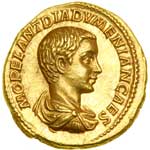 |
Diadumenian, AD 218. Gold Aureus (7.2g) minted at Rome, AD 218. M OPEL ANT DIADVMENIAN CAES. Bare-headed, draped and cuirassed bust right of Diadumenian. Reverse: SPES PVBLICA. Spes (Hope) advancing left, holding flower in right hand, raising skirts with left. Sear 7445; Calicó 2984a; RIC 115. Published in Wealth of the Ancient World: The Nelson Bunker Hunt and William Herbert Hunt Collection, Kimbell Art Museum, Fort Worth, 1983, no. 141.
One of the classic rarities in Roman Coinage. Fantastic high relief portrait and delicately toned. Lustrous. Superb Extremely Fine.
Marcus Opellius Diadumenianus, the ten-year-old son of the short-lived emperor Macrinus (AD 217-218), was granted the rank of Caesar soon after his father had succeeded the murdered Caracalla. Coinage in his name was struck in the full range of denominations, though his gold is extremely rare. This superbly preserved aureus carries the message that the young Caesar represents the hope of the future for the Roman people. Unfortunately for him, this was not to be the case. Macrinus' regime was overthrown after just fourteen months of rule when the Severan dynasty was restored in the person of Elagabalus, the son of Caracalla's cousin Julia Soaemias.
Estimated Value $80,000 - 100,000.
The Hunter Collection; Ex Michael F. Price Collection (Stack's, December 3, 1996, lot 226); Sotheby Hunt Sale, June 1990, lot 141; Leu 25, 1980, lot 367; Platt Hall Collection (Glendining's, 1950, lot 1767); Sir Arthur Evans Collection (Ars Classica 3, 1922, lot 106); Karnak find.
View details and enlarged photos
| Realized
$310,500 |
Lot 4177 |
 |
Diadumenian, AD 217-218. Silver Denarius (2.8g). Minted at Rome. September, AD 217 - May, AD 218. M OPEL ANT DIADVMENIAN CAES. Bare-headed and draped bust of Diadumenian right. Reverse: PRINC IVVENTVTIS. Diadumenian in military attire standing left, holding military standard in right hand and scepter in left; two standards to right. RIC 102; C-3; RSC 3. Virtually as struck and lustrous. Nearly Mint State.
This attractive silver denarius was struck in Rome soon after Diadumenian's elevation to the rank of Caesar, perhaps in celebration of his ninth birthday in September, AD 217. The obverse displays the Roman master of coin portraiture during the Severan era and wonderfully conveys the subject's youth and innocence. The reverse depicts Diadumenian standing amid Roman military standards in his role as 'Prince of Youth,' a title traditionally given to the heir to the imperial throne.
Estimated Value $1,000 - 1,300.
Ex Numismatica Ars Classica AG 62, lot 2049; Ex Gorny & Mosch sale 142, 2005, lot 2762.
View details and enlarged photos
| Realized
$2,300 |
Lot 4178 |
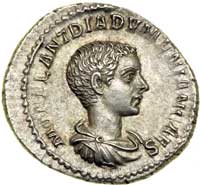 |
Diadumenian, AD 217-218. Silver Denarius (3.4g) minted at Rome. Bare-headed, draped and cuirassed bust of Diadumenian right. Reverse: Diadumenian in military attire standing left, head back, holding standard and scepter; two standards behind. RIC 102 (Macrinus); RSC 3a. Soft gray toning. Exceptional depiction of Diadumenian rendered with meticulous detail. Extremely Fine.
Estimated Value $800 - 900.
The Hunter Collection.
View details and enlarged photos
| Realized
$1,955 |
Lot 4179 |
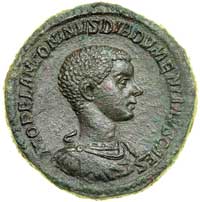 |
Diadumenian, as Caesar, AD 217-218. AE Sestertius (23.9g) minted at Rome. M OPEL ANTONINVS DIADVMENIANVS CAES. Bare-headed, draped and cuirassed bust right of youthful Diadumenian. Reverse: [PRI]NC IVVENTVTIS SC. Diadumenian in military attire standing facing, head right, holding standard in right hand, baton in left; to right, two standards. Sear 7453; RIC 211; Banti 3. Vivid portrait on a wonderful round flan. Forest-green patina with light earthen red hues. Certainly among the finest known. Very rare. Extremely Fine.
Estimated Value $25,000 - 35,000.
The Hunter Collection; Ex Superior Stamp & Coin NYINC Auction, December 8-9, 1995, lot 952; Numismatica Ars Classica 6, lot 478.
View details and enlarged photos
| Realized
$77,625 |
Lot 4180 |
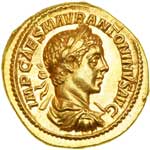 |
Elagabalus, AD 218-222. Gold Aureus (6.5g) minted at Rome, AD 219. IMP CAES M AVR ANTONINVS AVG. Laureate, draped and cuirassed bust right of young Elagabalus. Reverse: PONTIF MAX TR P II COS II PP. Roma seated left, holding Victoria (Victory) presenting wreath right on right hand, spear in left; shield resting at her side. Calicó 3024; RIC 26d; cf. Sear 7479 (obverse legend). A simply marvelous gem specimen and absolutely superb with fully lustrous surfaces. Virtually as struck. Nearly Mint State.
Estimated Value $25,000 - 30,000.
The Hunter Collection; Ex Michael F. Price Collection (Stacks, December 3, 1996, lot 228).
View details and enlarged photos
| Realized
$69,000 |
Lot 4181 |
 |
Severus Alexander, AD 222-235. Gold Aureus (6.72g) minted at Rome, AD 231. Laureate, draped and cuirassed bust of Alexander right. Reverse: Jupiter standing three-quarters left, head back, about to hurl thunderbolt; drapery billowing. RIC 234; Calico 3060; Cohen 75. Trivial scratch across neck and garment. Toned with underlying luster. Fine style with excellent portrait in high relief. Extremely Fine.
Estimated Value $4,000 - 5,000.
View details and enlarged photos
| Realized
$8,625 |
Lot 4182 |
 |
Maximinus I, AD 235-238. AE 30 (16.81g). Provincial issue minted at Cremna in Pisidia. IMP CAE C IVL VER MAXIMINO A-VG. Laureate, draped and cuirassed bust of Maximinus right. Reverse: MAR(O)N COL CRE. Marsyas standing facing, head left, raising his right hand and holding wine skin over his shoulder with his left. Von Aulock Pisidiens 1345 corr (obv. legend, same dies); Von Aulock cites only three examples, all in museum collections (ANS, Boston MFA, Staatliche Museen zu Berlin). Even green patina with light earthen highlights. Fine style. Choice Very Fine.
Estimated Value $1,000 - 1,300.
Ex Sternberg XI, 20 November 1981, lot 340.
View details and enlarged photos
| Realized
$1,323 |
Lot 4183 |
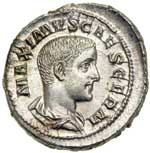 |
Maximus, son of Maximinus I (as Caesar) AD 235-238. Silver Denarius (3.5g) minted at Rome. Bare-headed, draped bust of Maximus I, right. Reverse: Maximus I standing left, holding baton and transverse spear; to right, two standards. RIC-3; C-10. Superb Extremely Fine.
Estimated Value $1,500 - 2,000.
The Wolfen Family Foundation Collection; Ex Numismatic Fine Arts, early 1970s.
View details and enlarged photos
| Realized
$2,185 |
Lot 4184 |
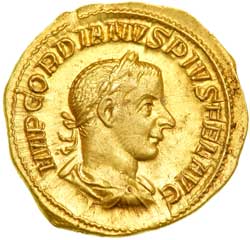 |
Gordian III, AD 238-244. Gold Aureus (4.90g) minted at Rome, AD 243-244. Laureate, draped and cuirassed bust of Gordian III right, seen from behind. Reverse: SECVRIT PERP. Securitas (Security) standing left, leaning on a column and holding a scepter. Calicó 3232; cf. RIC 164 (SECVRITAS). Boldly struck, a marvelous example. Lustrous. Extremely Fine.
Estimated Value $4,000 - 5,000.
View details and enlarged photos
| Realized
$5,175 |
Lot 4185 |
 |
Gordian III, AD 238-244. Gold Aureus (5.05g) minted at Rome, AD 239. Laureate, draped and cuirassed bust of Gordian III right, seen from behind. Reverse: Victoria (Victory) advancing left, on her tip-toes, holding a laurel wreath before her and a palm frond in her left hand. RIC 24; Calicó 3214. Toned with underlying luster present. A pleasing, very youthful and pensive portrait. Extremely Fine.
Estimated Value $4,000 - 5,000.
View details and enlarged photos
| Realized
$5,175 |
Lot 4186 |
 |
Gordian III, AD 238-244. Gold Aureus (5.03g) minted at Rome, AD 241-243. Laureate, draped and cuirassed bust of Gordian III right, seen from behind. Reverse: Sol (Sun) standing facing, head left, right hand raised, holding globe in his left hand. RIC 97; Calicó 3186a; Cohen 37. Trivial deposits. Nice broad borders with underlying luster. Extremely Fine.
Estimated Value $4,000 - 5,000.
View details and enlarged photos
| Realized
$5,060 |
Lot 4187 |
 |
Gordian III, AD 238-244. Gold Aureus (4.50g) minted at Rome, AD 241-243. Laureate, draped and cuirassed bust of Gordian III right, seen from behind. Reverse: Sol (Sun) standing facing, head left, right hand raised, holding globe in his left hand. RIC 97; Calicó 3186a; Cohen 37. Pleasing rose color toning with underlying luster. Extremely Fine.
Estimated Value $4,000 - 5,000.
View details and enlarged photos
| Realized
$5,175 |
Lot 4188 |
 |
Gordian III, AD 238-244. Gold Aureus (5.08g) minted at Rome, AD 239. Laureate, draped and cuirassed large bust of Gordian III right, seen from behind. Reverse: PM TR P II COS II. Jupiter standing left, holding scepter and thunderbolt, spreading his cloak over a small figure of Gordian III standing left before him. RIC 21; Calicó 3211a. Trivial deposits noted. Toned with underlying luster. Rare. Extremely Fine.
Estimated Value $4,000 - 5,000.
View details and enlarged photos
| Realized
$5,060 |
Lot 4189 |
 |
Gordian III, AD 238-244. Gold Aureus (4.94g) minted at Rome, AD 238-240. Laureate, draped and cuirassed bust of Gordian III right, seen from behind. Reverse: PROVIDENTIA AVG. Providentia (Providence) standing left on groundline, holding a globe and scepter. RIC 10; Calicó 3230. Toned. Sharp, pleasing types, with excellent luster. Extremely Fine.
Estimated Value $4,000 - 5,000.
View details and enlarged photos
| Realized
$8,625 |
Lot 4190 |
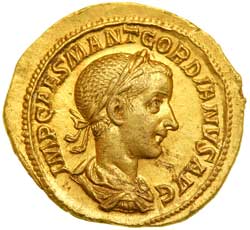 |
Gordian III, AD 238-244. Gold Aureus (4.90g) minted at Rome, AD 239. Laureate, draped and cuirassed bust of Gordian III right. Reverse: PM TR P II COS PP. Providentia standing left on short groundline, holding globe and scepter. RIC 23; Calicó 3213. Toned and lustrous. Extremely Fine.
Estimated Value $4,000 - 5,000.
View details and enlarged photos
| Realized
$5,060 |
Lot 4191 |
 |
Gordian III, AD 238-244. Gold Aureus (5.1g) minted at Rome, AD 241. Laureate, draped and cuirassed bust of Gordian III right, seen from behind. Reverse: Diana standing right, holding a long torch diagonally with both hands. RIC 121; Calicó 3191; Cohen 39. Some minute marks about the outer reverse rims and a small flan crack at 1 o'clock as made. Well struck and toned, with underlying luster. Rare. Extremely Fine.
Estimated Value $4,000 - 5,000.
View details and enlarged photos
| Realized
$5,290 |
Lot 4192 |
 |
Gordian III, AD 238-244. Gold Aureus (4.95g) minted at Rome, AD 239. Laureate, draped and cuirassed large bust of Gordian III right. Reverse: PM TR P II COS PP. Jupiter standing left, holding scepter and thunderbolt, spreading his cloak over a small figure of Gordian III standing left before him. RIC 21; Calicó 3211a. Boldly struck and toned, with underlying luster. Lovely high relief portrait. Rare. Extremely Fine.
Estimated Value $4,000 - 5,000.
View details and enlarged photos
| Realized
$7,763 |
Lot 4193 |
|
Withdrawn
| Unsold |
Lot 4194 |
 |
Gordian III, AD 238-244. Gold Aureus (5.23 g) minted at Rome, AD 239. Laureate, draped and cuirassed bust of Gordian III right, seen from behind. Reverse: PM TR P II COS PP. Pax (Peace) standing left holding laurel branch and scepter. RIC 22; Calicó 3215. Some small surface pecks and marks on the face and neck along with some minor reverse deposits. Toned. About Extremely Fine.
Estimated Value $3,000 - 4,000.
View details and enlarged photos
| Realized
$4,370 |
Lot 4195 |
 |
Gordian III, AD 238-244. Gold Aureus (5.2g) minted at Rome, AD 241-243. Laureate, draped and cuirassed bust of Gordian III right, seen from behind. Reverse: Sol (Sun) standing facing, head left, right hand raised, holding globe in his left hand. RIC 97; Calicó 3186a; Cohen 37. Reverse struck from worn dies. Nice broad borders with underlying luster and lightly toned. Extremely Fine / Very Fine.
Estimated Value $3,000 - 4,000.
View details and enlarged photos
| Realized
$4,830 |
Lot 4196 |
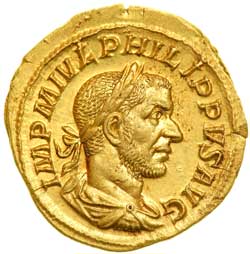 |
Philip I, AD 244-249. Gold Aureus (4.92g) minted at Rome, AD 244-247. Laureate, draped and cuirassed Philip bust right. Reverse: Fides standing left holding a military standard in each hand. RIC 34, Calicó 3247 (R5). Very Rare. Trivial reverse dirt with underlying luster present. Extremely Fine.
The reverse here reflects the importance of the loyalty of the Roman legions to their emperor and, of course, the emperor's hope and need for just that. By this period in Roman history, though, such loyalty had become, and would increasingly become, more fickle and it would be the case for Philip. After two years along the Danubian frontier repelling invasions by the Carpi, Philip returned in triumph to Rome in AD 247. His glory was short lived.
In the spring or early summer of 248, the Danubian legions, apparently tired of Philip, hailed Pacatian as emperor. This rebellion was eventually stamped out, but two others occurred on the Rhine and the Danube. The vicious rule of Philip's brother, Priscus in the eastern part of the empire, meanwhile, ignited the East in a rebellion by the legions lead by Jotapian. In AD 249, Trajan Decius, the man Philip sent to quell the unrest in Moesia and Pannonia, was hailed emperor by the soldiers of his command. Philip was killed in the ensuing battle.
Estimated Value $15,000 - 20,000.
View details and enlarged photos
| Realized
$46,000 |
Lot 4197 |
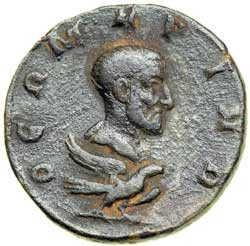 |
Julius Marinus, father of Philip I (died before AD 244). AE 23 (9.5g). Struck at Philippopolis in Syria Trachonitis. ΘEΩMAPINΩ. Bare-headed bust of Julius Marinus right, drapery on far shoulder; supported by eagle standing right, beating its wings. Reverse: ΦIΛIΠΠOΠOΛITΩN KOΛΩNIAΣ S - C. Helmeted Roma standing left, holding patera and long spear and shield at feet to right. SNG ANS 1402; BMC Arabia pg. 42,2. Spijkermann, The Coins of the Decapolis and the Provincia Arabia, 2 and pl. 58, 2. A very choice specimen, with a dark brown patina and light earthen highlights. Very rare in such exceptional condition. Choice Very Fine.
Little is known of Philip's father, save his name, Julius Marinus. Philip deified his deceased father, and the local authorities began striking coins depicting his image being borne to heaven on the back of an eagle, a classical motif indicating apotheosis.
The coinage was quite limited, consisting of only two bronze denominations. It was confined to the immediate vicinity of Philippopolis, though the legend S C on the reverse indicates the issue had been authorized by the Roman Senate, perhaps as a show of respect for the new emperor. Coins of Julius Marinus remain quite rare today and the issue is one of the few examples of a third century Roman coin depicting a personage who was not a Roman emperor or empress.
Estimated Value $5,000 - 6,000.
Ex Numismatica Ars Classica 62, lot 2059; Ex CNG sale 72, 2006, lot 1250.
View details and enlarged photos
| Unsold |
Lot 4198 |
 |
Trajan Decius, AD 249-251. AE Double Sestertius (37.9g) minted at Rome, AD 250. IMP C M Q TRAIANVS DECIVS AVG. Radiate and cuirassed bust of Trajan Decius right, with slightly draped left shoulder. Reverse: FELICITAS SAECVLI. Felicitas (Happiness) standing left, holding long caduceus in right hand, cornucopiae in left; in fields, S C. Sear 9395; RIC 115; Cohen 40; Kent-Hirmer 462 var; Hunter 44. Area of light obverse tooling and a small spot of reverse corrosion. Medallic in appearance with a fine reddish brown patina. A fabulous specimen. Extremely Fine.
The mid-third century ruler Trajan Decius had the dubious distinction of being the first Roman emperor to fall in battle against a foreign enemy (the Goths). During his brief reign (AD 249-251) Decius found time to give attention to the Imperial coinage which was undergoing a rapid debasement. His two most remarkable innovations were the introductions of a medallic double sestertius and a small bronze coin which is usually described as a semis, though this denomination had not been produced since Hadrianic times. The double sestertius was issued also in the name of his wife Herennia Etruscilla, though most surviving specimens are of the emperor himself. There are three reverse types, Felicitas, Victory and a Liberalitas scene with the emperor and his elder son Herennius Etruscus. The denomination was abandoned by Decius' successor Trebonianus Gallus, though the Gallic usurper Postumus revived it for a while.
Estimated Value $10,000 - 13,000.
The Hunter Collection; Ex Superior Stamp & Coin NYINC Auction, December 8-9, 1995, lot 984; The Nelson Bunker Hunt Collection, Sotheby's, June 19-20, 1991, Lot 865.
View details and enlarged photos
| Realized
$10,638 |
Lot 4199 |
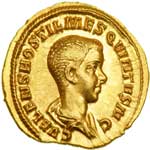 |
Hostilian, as Caesar, AD 250-251. Gold Aureus (3.8g) minted at Rome. C VALENS HOSTIL MES QVINTVS N C. Bare-headed and draped bust right of Hostilian. Reverse: PRINCIPI IVVE - NTVTIS. Hostilian in military attire standing left, holding standard in right hand, spear in left. Sear 9550; Calicó 3316; RIC 181b. Wonderful delicate portraiture. Very rare. Lustrous. Superb Extremely Fine.
Gaius Valens Hostilianus Messius Quintus was the younger son of Trajan Decius and Herennia Etruscilla. He was raised to the rank of Caesar at the end of AD 250 and was left as the only surviving male representative of the imperial family when his father and elder brother were killed in battle against the Goths. Because he was only about twelve years of age, there was no possibility that he could take control of the state in a situation of military emergency. However, the choice of the army to be the next emperor, Trebonianus Gallus, allowed Hostilian to retain his imperial power and even elevated him to the rank of Augustus and co-emperor. Just a few months later the unfortunate boy fell victim to the plague that was ravaging the Empire, and his place as co-emperor was taken by Gallus' own son Volusian.
Hostilian's gold coinage is very rare, and this specimen is an exceptionally fine example. The reverse depicts him as "Leader of the Youth," a title regularly bestowed on the heir to the throne.
Estimated Value $25,000 - 30,000.
The Hunter Collection.
View details and enlarged photos
| Realized
$63,250 |
Lot 4200 |
 |
Aemilian, AD 253. Silver Antoninianus (2.9g). Minted at Rome, July-September AD 253. IMP AEMILIANVS PIVS FEL AVG. Radiate, draped and cuirassed bust of Aemilian right. Reverse: VIRTVS AVG. Emperor standing left in military dress, right foot on helmet, holding spear in left hand and branch in right. RIC 12; RSC 60. Well struck in good metal, with an exceptional portrait. Rare. Extremely Fine.
By AD 253, the coinage of the Roman Empire was in a sorry state, with rampant inflation of its value worsened by continuing debasement of its metal. Nevertheless, this silver double-denarius, often called an antoninianus, bears an excellent portrait of Aemilian, depicting him as a tough military man with a close-cropped beard. The metal quality is also superior to the debased standards of the era.
Estimated Value $750 - 900.
Ex Numismatica Ars Classica 62, lot 2066.
View details and enlarged photos
| Realized
$863 |
Lot 4201 |
 |
Uranius Antoninus, AD 253-254. Gold Aureus (5.8g) minted at Emesa. L IVL AVR SVLP VRA ANTONINVS. Laureate, draped and cuirassed bust right of bearded Uranius Antoninus. Reverse: FE - CVND - ITAS AVG. Fecunditas (Fertility-Fortune) standing left, resting right hand on rudder, holding cornucopiae in left. Sear 9883; Calicó 3385; RIC 3. Some flatness of strike on the right side legend, not effecting the portrait.
One of the great rarities in Roman Coinage. Lustrous. Extremely Fine.
One of several misfortunes that befell the Empire during the two-year reign of Trebonianus Gallus was an invasion of Syria by the Sasanid ruler Shapur I. The invaders even besieged and captured the capital city of Antioch. Emesa was also attacked, but the Persians were repulsed under the leadership of Sampsigeramus, high priest of the sun god Elah-Gabal. No coins are known in the name of Sampsigeramus, but there is an interesting series of gold aurei, billon tetradrachms and bronzes with the name of a certain Uranius Antoninus, otherwise unknown to history. These are clearly of Syrian fabric, and it seems reasonable to surmise that Sampsigeramus and Uranius Antoninus are the same individual. The identification is further strengthened by the copying of some of the aureus reverses from Severan prototypes, since Emesa was the home of Julia Domna, wife of Septimius Severus. A provincial bronze even names the mint as Emesa and gives its precise date as AS 565 = AD 253/4. Curiously, the usual imperial titles of Imperator and Augustus are omitted on the gold while they appear as usual on the provincial billon and bronze.
Estimated Value $30,000 - 40,000.
The Hunter Collection.
View details and enlarged photos
| Realized
$86,250 |
Lot 4202 |
 |
Gallienus, AD 253-268. Gold Quinarius (light Aureus) (2.3g) minted at Rome. Bust of Gallienus right with large laurel wreath. Reverse: Uberitas standing left holding a bunch of grapes and cornucopiae. RIC p.140, 120 (R); Calicó 3594a (R3). Small old file mark on obverse edge. Very lustrous and very rare. Crisp details and a light crease in the flan, otherwise. Superb Extremely Fine.
Estimated Value $4,000 - 5,000.
The Hunter collection.
View details and enlarged photos
| Realized
$4,025 |
Lot 4203 |
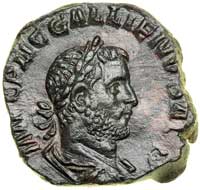 |
Gallienus, AD 253-268. AE Sestertius (19.0g) minted at Rome, AD 253-254. IMP C P LIC GALLIENVS A[V]G. Laureate and draped bust right of bearded Gallienus. Reverse: [VI]RTVS AVGG S C. Virtus (Valor) standing left, resting right hand on grounded shield, holding spear in left. Sear 10495; RIC 248; Banti 83; Cohen 1295. Bold portrait, finely detailed.
A particularly choice example and quite rare in such a high state of preservation. Extremely Fine.
Estimated Value $2,000 - 2,500.
The Hunter Collection; Ex Superior Stamp & Coin NYINC Auction, December 8-9, 1995, lot 987; Peus 338, lot 717.
View details and enlarged photos
| Realized
$3,795 |
Lot 4204 |
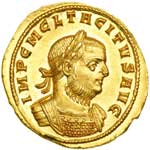 |
Tacitus, AD 275-276. Gold Light Aureus (4.5g) minted at Ticinum or Siscia. IMP C M CL TACITVS AVG. Laureate and cuirassed bust right of bearded Tacitus, left shoulder slightly draped. Reverse: MARS VI - CTOR. Mars walking right, holding spear in right hand, trophy over left shoulder; at his feet to right, captive. Sear 11748; Calicó 4074; RIC 112. Fine hairlines from old cleaning noted. Fully lustrous. Nearly Mint State.
Estimated Value $13,000 - 15,000.
The Hunter Collection.
View details and enlarged photos
| Realized
$39,100 |
Lot 4205 |
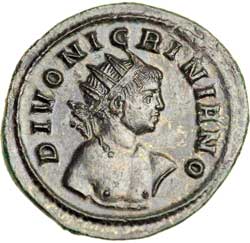 |
Nigrinian, son of Carinus (died AD 284). Billon Aurelianianus (Antoninianus) (3.40 gm). Minted at Rome, AD 284-285. DIVO NIGRINIANO. Radiate, nude half-length bust of Nigrinian shown from front, head turned to right, right shoulder raised. Reverse: CONSECRATIO. Eagle standing facing, wings spread, head left, KAA in exergue. RIC 472; Sear 12412; Cohen 3. The portrait is of unmatched artistry for the period. Glossy dark brown patina. Very rare. Superb Extremely Fine.
Nigrinian's coins are of considerable rarity, indicating that striking commenced shortly before the downfall of Carinus' regime early in AD 285 and was quickly brought to an abrupt halt. His coinage is limited to gold aurei (which are exceedingly rare) and billon aurelianianni, such as this example. His successor, Diocletian, condemned the memory of Carinus and no doubt revoked the deification of Nigrinian, who thus became a long-lost footnote to Roman history.
This remarkable billon aurelianianus bears a stunning half-length bust of Nigrinian that can only be described as a masterpiece of numismatic portraiture from this troubled era. The youth is shown "heroically nude" and with one shoulder raised, perhaps indicating it was modeled on a statue of Nigrinian in an oratorical pose. This pristine example with the 'heroic bust' is among the most desirable of the surviving examples known.
Estimated Value $5,000 - 6,000.
View details and enlarged photos
| Realized
$6,325 |
Lot 4206 |
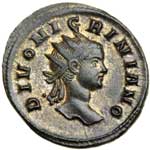 |
Nigrinian, son of Carinus (died AD 284). Billon Aurelianianus (Antoninianus) (3.5g) minted at Rome, AD 284-285. DIVO NIGRINIANO. Radiate head right of Nigrinian. Reverse: CONSECRATIO. Eagle standing facing, head left, wings spread; in exergue, KAA. Sear 12411; RIC 472. Well struck, with a lovely medium brown patina and golden highlights. Very rare. Extremely Fine.
History records that the emperor Carus (AD 282-283) had a grandson of this name but beyond that, nothing is known of this prince. It appears likely that he was the son of Carinus and Magnia Urbica and that he died in infancy in AD 284. His rare coinage was struck concurrently with issues in the names of Divus Carus (died AD 283) and Divus Numerian (died AD 284).
Estimated Value $4,000 - 5,000.
The Hunter Collection.
View details and enlarged photos
| Realized
$3,910 |
Lot 4207 |
 |
Diocletian, AD 284-305. Gold Aureus (5.1g) minted at Rome, AD 287. DIOCLETIA - NVS P F AVG. Laureate, draped and cuirassed bust right of Diocletian. Reverse: IOVI FVL - GE - RAT - ORI. Jupiter standing left, head and torso right, poised to hurl thunderbolt brandished in raised right hand; at his feet to right, anguipede giant; in exergue, P R. Sear 12558; Calicó 4531; Jameson 310 (same dies); cf. RIC 146 (FVLGVRATORI in error). Lustrous. Only four specimens published. Superb Extremely Fine.
When, at the end of the third century, Diocletian devised his new tetrarchic system of government, the two imperial houses of East and West each adopted a different god as their special guardian deity. In the West, Maximian and his Caesar Constantius chose Hercules as their protector, and his image appears frequently on their coins. Similarly, the eastern rulers Diocletian and Galerius came under the special protection of Jupiter, chief deity of the Greco-Roman pantheon, and a wide variety of different representations are shown, especially on the gold coinage.
On this aureus of the Rome mint, Jupiter appears as the Thunderer (Iupiter Fulgerator) hurling his thunderbolt at Porphyrion, king of the twenty-four anguipede giants who made war on Olympus.
Estimated Value $10,000 - 13,000.
The Hunter Collection; Ex Harlan J. Berk Sale 89, February 14, 1996, lot 15.
View details and enlarged photos
| Realized
$13,800 |
Lot 4208 |
 |
Domitius Domitianus, ca. AD 296-298. AE Follis (8.5g) minted at Alexandria. Third officina.Laureate head right of the rebel. Reverse: Genius standing left holding a patera and cornucopiae; eagle at his feet; Γ in right field. RIC 20 var; Sear 12980. Deep glossy tan-brown patina with some earthen green. Very rare. Choice Very Fine.
Other than some minor references in papyri and contemporary writings of the time, we have no substantive information on this enigmatic ruler, and what little we know is gleaned in good part from his coinage. Rebellion broke out in Egypt in either AD 296 or AD 297. Some historians have linked the uprising with aggression on the part of the Sasanian king Narses who attacked Armenia and threatened Syria in AD 296, then resoundingly defeated Galerius, who had been sent by Diocletian. Other historians, though, believe the Egyptian rebellion began first and gave impetus and opportunity to the Sasanian aggressions. There were surely multiple causes driving the revolt in Egypt; but heavy taxation and social and commercial stagnation under Roman rule were leading factors.
Estimated Value $1,000 - 1,400.
Ex Wolfen Family Foundation, purchased from Numismatic Fine Arts, early 1970s.
View details and enlarged photos
| Realized
$2,185 |
Lot 4209 |
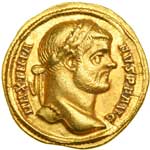 |
Maximian, AD 286-305. Gold Aureus (5.0g) minted at Rome, ca. AD 287. MAXIMIA - NVS P F AVG. Laureate head right of bearded Maximian. Reverse: HERCVLI VICTORI. Hercules seated facing, head right, on pile of rocks, with hands crossed on his lap; lion-skin draped over right leg; club resting against left knee; quiver and bow against right; in exergue, PR. Calicó 4680; cf. Sear 13032; RIC 13 (Trier). Apparently, only four specimens published. Extremely Fine.
Maximian, Diocletian's colleague and emperor of the western provinces from AD 286, was under the special protection of Hercules, as was his Caesar Constantius. Many reverse types of these rulers are devoted to the deity, and this aureus of Rome shows him seated facing in repose with his usual attributes, accompanied by the inscription "Hercules the Victor".
Estimated Value $10,000 - 13,000.
The Hunter Collection; Ex Harlan J. Berk Sale 89, February 14, 1996, lot 19.
View details and enlarged photos
| Realized
$11,500 |
Lot 4210 |
 |
Maximian, AD 286-305. Silver Argenteus (2.8g). Minted at Rome, ca. AD 294. MAXIMI-ANVS AVG. Laureate head of Maximian right. Reverse: VICTORI-A SARMAT, Four tetrarchs sacrificing over tripod before archway in six-turreted enclosure. RIC 17; RSC 548B. Virtually as struck. Lustrous, Nearly Mint State.
Estimated Value $800 - 900.
View details and enlarged photos
| Unsold |
Lot 4211 |
 |
Constantius I, Chlorus, as Caesar, AD 293-305. Gold Aureus (5.8g) minted at Rome, AD 293-294. Laureate head of Constantius right, legend begins: DN… Reverse: Constantius standing left, dressed in military attire, holding standard and scepter; VROM in exergue. Calicó 4866 (R2), RIC--; Sear 13916; Cohen 233. Well struck on a pleasing flan. Lustrous Superb Extremely Fine.
Calicó notes that the title D.N. (Dominus Nostre) was not used at this time, and the aureus may have been issued by a different emperor.
Estimated Value $10,000 - 13,000.
The Hunter Collection.
View details and enlarged photos
| Realized
$26,450 |
Lot 4212 |
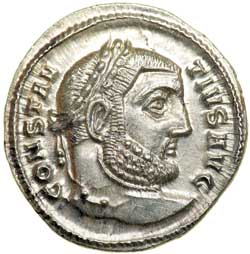 |
Constantius I, Chlorus, AD 305-306. Silver Argenteus minted at Serdica, fourth officina. Laureate head of Constantius right. Reverse: Camp gate with open door, three turrets and seven layers of stone; SM.SD Δ in exergue. RIC 11a var (unlisted officina); Sear 14169. Perfectly struck and fully lustrous. A gem specimen. Mint State.
Estimated Value $1,000 - 1,300.
View details and enlarged photos
| Realized
$1,323 |
Lot 4213 |
 |
Galerius, as Caesar, AD 293-305. Gold Aureus (5.3g) minted at Heraclea, ca. AD 293-295. MAXIMIANVS NOB CAES. Laureate head of Galerius right. Reverse: IOVI CONS CAES. Jupiter standing left, holding thunderbolt and scepter; eagle before at feet; * ends legend; SMHΣ in exergue. Sear 14208; Calicó 4910; RIC 10; Depeyrot 9/5; Cohen 118. Boldly struck in high relief. Lustrous and superb. Nearly Mint State.
Galerius was born near present-day Sofia, Bulgaria. His mother Romula was a pagan priestess from the far side of the Danube and seems to have fueled his lifelong hatred for Chistianity. He found a career in the military and rose steadily through the ranks, becoming Praetorian Prefect under Diocletian, who soon took notice of his leadership skills. On March 1, AD 293, Galerius was made Caesar of the East, reporting directly to Diocletian. Thanks to Galerius and his army, in AD 296 a great deal of the Persian Empire fell under Roman control, winning Galerius a well-deserved triumph. His influence over Diocletian grew steadily from then on. In AD 302 he induced Diocletian to launch the Great Persecution, an all-out effort to crush Christianity root and branch. The effort only served to create more martyrdoms and inspire the faithful. In AD 305, Diocletian abdicated, and Galerius became Augustus of the East. Although technically subordinate to Constantius I in the West, Galerius had already arranged that the new Caesars, Severus II and Maximinus Daza, would be exclusively loyal to him. But the death of Constantius the following year launched a chain reaction of upheaval that threw the Tetrarchic system into chaos, and Galerius spent the rest of his reign desperately trying to restore some semblence of order. In AD 310 he fell victim to a wasting disease that left him horribly disfigured and in constant pain. The Christians claimed it was God's vengeance, and Galerius seems to have at least partly believed it, for he ordered the persecution to be formally ended just five days before he died in May, AD 311.
Estimated Value $12,000 - 15,000.
The Hunter Collection.
View details and enlarged photos
| Realized
$39,100 |
Lot 4214 |
 |
Galerius, as Caesar. AD 293-305. Silver Argenteus (3.0 g). Minted at Rome, ca. AD 294. MAXIMIA-NVS CAES. Laureate head of Galerius right. Reverse: PROVIDEN-TIA AVGG. Four tetrarchs sacrificing at arched gate before six-turreted enclosure. RIC 11b; RSC 183a. Well-centered and virtually as struck. Lustrous, Nearly Mint State.
Estimated Value $800 - 900.
View details and enlarged photos
| Unsold |
Lot 4215 |
 |
Domitius Alexander, AD 308-310. AE Follis (4.89g) minted at Carthage, AD 308-310. Usurper in North Africa. IMP ALEXANDER P F AVG. Laureate head right of bearded Alexander. Reverse: AFR - IC - A AVG N. Africa standing facing, head left, wearing elephant headdress, holding standard in right hand, elephant's tusk in left; at feet to left, lion; in exergue, PK. Sear 15080; RIC 64. Uniform reddish-brown patina. Extremely Rare. Nearly Extremely Fine.
This very rare follis of the North African usurper Domitius Alexander (AD 308-310) was issued at his capital city of Carthage, the only mint that he controlled. The reverse has a personification of Africa holding a military standard and a large elephant's tusk. This short-lived usurper came to power at a time of great complexity in the politics of the Empire's western provinces. A reluctant participant in the power struggle, Alexander was persuaded by Maximian and his son-in-law Constantine to raise the standards of rebellion against Maxentius, who controlled Italy and Africa. The consequent interruption in Rome's vital grain supply threatened famine in the city and undermined Maxentius' regime. However, after two years, Alexander was defeated by Maxentius' praetorian prefect Rufius Volusianus, and the grain supply was restored. This was only a temporary reprieve for Maxentius, as in AD 312 he was overthrown by Constantine who defeated him in battle just outside Rome.
Estimated Value $7,000 - 9,000.
The Hunter Collection; Ex Leu 30, 28 April 1982, lot 471; Giuseppe Mazzini Collection, 1.
View details and enlarged photos
| Realized
$10,638 |
Lot 4216 |
 |
Licinius II, AD 317-32. Gold Aureus (5.2g) minted at Nicomedia, AD 321-322. D N VAL LICIN LICINIVS NOB C. Bare-headed, draped and cuirassed bust facing of Licinius Junior. Reverse: IOVI CONSER - VATORI CAES. Jupiter seated facing on platform, holding Victory standing right on globe in his right hand, resting left on scepter; at his feet to left, eagle standing left, head reverted; Victory and eagle each presenting a wreath; platform inscribed SIC V / SIC X in two lines; in exergue, SMNΓ. Sear 15391; Calicó 5151; RIC 42. Some microscopic scattered hairlines noted. A marvelous example of the full-facing image of the young emperor. Lustrous. Superb Extremely Fine.
Frontal imperial portraits, which were to be a feature of the late Roman and Byzantine coinage, were extremely rare in the early centuries of the Roman imperial coinage. Maxentius began using them on some of his aurei issued at Ostia in the final two years of his reign (AD 310-312), and Licinius showed a propensity to feature them on aurei of Nicomedia and Antioch issued in AD 321/322. This splendid example is in the name of the Caesar Licinius Junior. The rather sketchy portrait of the six-year-old prince is a clear indication that the Nicomedian die engravers of this period had not yet fully mastered the art of frontal portraiture.
Estimated Value $25,000 - 35,000.
The Hunter Collection.
View details and enlarged photos
| Realized
$35,650 |
Lot 4217 |
 |
Valerius Valens, AD 316-317. AE Follis (4g). Minted at Alexandria, October-December AD 316. Usurper in the East. IMP C AVR VAL VALENS P F AVG. Laureate head of Valens right. Reverse: IOVI CONSER-VATORI AVGG. Jupiter standing left, holding Victory on globe in right hand and scepter in left; eagle holding wreath in beak standing before; K in left field; wreath over X / B in right field; ALE in exergue. RIC VII 19 (R5) var (different officina); Cc-2 var (officina not recorded). Exceptionally well struck on a full flan with a pleasing dark chocolate brown patina. Extremely rare. Easily the finest of fewer than a dozen known specimens. Superb Extremely Fine.
The brief "reign" (only three-months) of Gaius Aurelius Valerius Valens, took place amid the power struggle between Licinius, Roman emperor of the East, and his western counterpart, Constantine I "the Great." Though allies during the civil wars following the collapse of the Second Tetrarchy (AD 308-312), Constantine and Licinius soon fell to bickering. Valens was a general in Licinius' service, probably a career soldier from the Danubian provinces, as were most important military men of his day. His place and date of birth are unknown. By AD 316, Valens had risen to the post of Dux Limitis in Dacia, placing him in overall command of Licinius' Balkan armies. The post was a critical one, as tensions were rising between the rival emperors and forces were being massed at their mutual border. On October 8, AD 316, Constantine launched a preemptive strike on Cibalae, in present-day Bulgaria. Despite having superior numbers, Licinius was forced to retreat. But he paused at Serdica (modern Sofia) and defiantly proclaimed that Constantine, due to his illegal aggression, had been officially deposed. He then appointed his loyal general Valens as Augustus of the West in Constantine's place. Licinius instructed Valens to hold the line as long as possible while he raised reinforcements. But after another setback, Licinius slipped away into Asia Minor, leaving Valens and the rearguard stranded and surrounded. Defeated and outmaneuvered, Licinius sued for peace and was granted fairly generous terms from Constantine, whose army had also suffered heavy casualties. The peace settlement, signed on March 1, AD 317, allowed Licinius to remain master of the East in return for ceding some Balkan territory and recognizing Constantine as senior Augustus. Constantine also demanded that Valens be deposed. Licinius not only deposed Valens but, for good measure, executed his faithful general and co-ruler as well. The whole sorry episode would be repeated scarcely seven years later.
Despite the ephemeral nature of his reign, a few bronze folles were struck for Valens at the mints of Cyzicus in Asia Minor and Alexandria in Egypt. The types, with their stylized portraiture and emphasis on Jupiter as "Protector of the Emperors," follow those of Licinius. This piece, with its crisp strike, attractive patina and absence of wear, is undoubtedly the finest surviving coin of Valerius Valens.
Estimated Value $25,000 - 30,000.
Ex Numismatica Ars Classica 62, lot 2094; Ex Triton X, 10 January 2007, lot 778.
View details and enlarged photos
| Realized
$42,550 |
Lot 4218 |
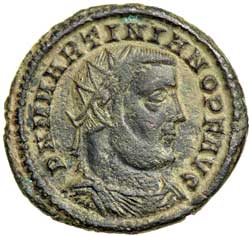 |
Martinian, AD 324. AE Follis (4.2g). Struck at Nicomedia, summer AD 324. Usurper in the East. D N MARTINIANO P F AVG, Radiate, draped and cuirassed bust of Martinian, right. Reverse: IOVI CONS-ERVATORI. Jupiter standing left, holding Victory on globe in right hand and eagle-tipped scepter in left; eagle at feet to left holding wreath in beak; captive at feet to right looking back, X over ΠΓ in right field, SMNB in exergue. RIC 46 (R3). Cohen 4. Attractive green patina, and in an unusually high state of preservation for the issue. Extremely rare. Choice Very Fine or better.
Proof that history can and does repeat itself can be found in the sad tale of Martinian, a nominal puppet ruler installed by the East Roman Emperor Licinius in the midst of his second civil war against Constantine I. Martinian was of obscure origin, but by the AD 320s he had risen to become the chief minister of Licinius, just as it became apparent that a final, fatal clash with Constantine was forthcoming. Late in AD 322, Constantine's troops encroached on Licinius' territory in pursuit of Gothic raiders. Although such incursions were permitted by treaty, Licinius chose to regard this as a provocation and declared war in the spring of AD 324. With a vast army and navy, Licinius advanced into Thrace to confront Constantine, who had a somewhat smaller army based at Thessalonica. But Constantine was much the better general and inflicted a heavy defeat on his rival. Licinius fell back to Byzantium, where his fleet was smashed by a flotilla led by Constantine's eldest son Crispus. Crossing to Chalcedon, Licinius declared Constantine deposed and raised Martinian to the office of Augustus with instructions to prevent Constantine from crossing into Asia Minor. It was an impossible task from the outset; Constantine easily evaded Martinian's blocking force, landed in Asia and quickly cornered Licinius at Nicomedia. Having no choice, Licinius surrendered on terms brokered by his wife (and Constantine's sister) Constantia. A few months later, when Licinius was detected plotting a return to power, Martinian was executed.
Like those of Valerius Valens, coins of Martinian are exceedingly rare. The reverse of this coin evokes "Jupiter the Protector," Licinius' patron deity, who notably failed to protect him and Martinian from the wrath of Constantine and his Christian god. Surviving examples tend to be heavily worn or damaged, but this specimen is in an exceptional state of preservation.
Estimated Value $10,000 - 12,500.
Ex Numismatica Ars Classica 62, lot 2097; NAC 38, 2007, lot 229; Numismatic Fine Arts XXV, 1990, lot 488; SKA Berne 2, 1984, lot 611; M & M 52, 1975, lot 762.
View details and enlarged photos
| Realized
$14,375 |
Lot 4219 |
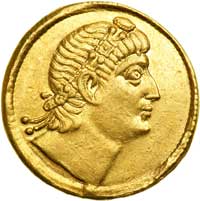 |
Constantine I, the Great, AD 307-337. Gold Solidus (4.3g) minted at Nicomedia, AD 335. Anepigraphic. Rosette-diademed head of Constantine right, his eyes uplifted. Reverse: VICTORIA CONSTANTINI AVG. Victoria (Victory) seated right on shield and cuirass, inscribing VOT / XXX on shield held by Genius; in exergue, SMNC. Sear 15758; Depeyrot 44/1; RIC 175. Old faint hairline on neck. The reverse legends are nice and sharp. Evocative portraiture, well struck and perfectly centered. Very rare. Lustrous. Extremely Fine.
Although the depiction of Constantine is perceived to subscribe to a Christian ideal, its iconography is derived from Alexander the Great portraits. During Constantine's time it was likely appealing to both followers of the new religion as well as followers of the old religions. The contemporary polemicist and historian Eusebius called the attribute of the upward gaze on Constantine's gold coins, a posture of prayer to God. The emperor's "pagan" subjects, though, would have picked up the coin and have been cheered by its Hellenistic antecedents.
Estimated Value $12,000 - 16,000.
The Hunter Collection; Ex Numismatic Fine Arts XXII, 1 June 1989, lot 131; Caruso Collection, 28 June 1923, lot 563.
View details and enlarged photos
| Realized
$16,675 |
Lot 4220 |
 |
Julian II, the Hellene, AD 361-363. Gold Solidus (4.4g) minted at Constantinople. FL CL IVLIA - NVS P P AVG. Pearl-diademed, draped and cuirassed bust of Julian right. Reverse: VIRTVS EXERCI - TVS ROMANORVM. Soldier striding right, his head left, a trophy over his shoulder, placing hand on the head of a captive crouching behind him; small pellet between captive's head and soldier; in exergue, CONSP and branch. RIC 157, Depeyrot 8/1. Well struck and perfectly centered with light golden-orange toning. Lustrous. Extremely Fine.
Estimated Value $6,000 - 8,000.
The Hunter Collection.
View details and enlarged photos
| Realized
$10,063 |
Lot 4221 |
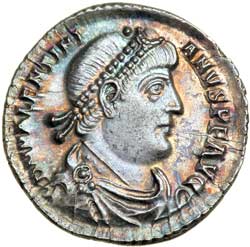 |
Valentinian I, AD 364-375. Silver Light Miliarense (4.3g). Minted at Trier, AD 367-375. D N VALENTINI-ANVS P F AVG. Draped, cuirassed and pearl-diademed bust of Valentinian I right. Reverse: VIRTVS EXERCITVS. Emperor standing facing in military attire, holding vexillum and resting hand on grounded shield, TRPS in exergue. RIC 26(a); RSC 58b Kent-Hirmer pl. 154, 711. Sharply struck, with beautiful multi-hued iridescent toning. A spectacular coin. Rare. Superb Extremely Fine.
The last truly great Emperor of the West, Valentinian I was born in AD 321, rising through army ranks to become a general. He received a solid education and followed his father into the army, becoming a cavalry officer and winning distinction under Constantius II. His Christianity, however, alienated him from the pagan Julian II, and he was demoted and banished to Egypt in the early 360s. After Julian's defeat and death in Persia in AD 363, his successor Jovian recalled Valentinian and placed him in command of the elite Scholarian Guard. Upon Jovian's death only a few months later, leaders of the Roman army proclaimed Valentinian emperor on February 25, AD 364. Valentinian made Milan his provisional capital but spent most of his time on the German frontier. Concerned that the burden of taxation was falling too heavily upon the poor, he appointed officers called "Protectors of the People" who made sure the rich paid their fair share. Though the Senatorial class deeply resented him as an uncultured brute, Valentinian possessed a firm understanding of administration as well as an appreciation for art and literature. He also followed a policy of strict religious tolerance, unlike rulers before and after him. He did, however, have a ferocious temper and kept a trained bear which he employed to maul those who greatly displeased him. After eleven successful years of rule, Valentinian's temper got the better of him during an audience with several Germanic chieftains in November AD 375. When they failed to show him proper respect, the emperor flew into a rage and suffered an apopletic stroke. His death proved a great tragedy for the Empire, as a man of his skill and energy might have averted the catastrophes that soon followed.
This large silver piece, the miliarense, was struck at the important provincial capital of Trier near the German frontier. The portrait portrays Valentinian as stern, stocky and clean-shaven in the tradition of fourth century Christian emperors, while the reverse depicts him in a general's armor, holding a banner (or vexillum) emblazoned with the Christian chi-rho symbol.
Estimated Value $5,000 - 6,000.
Ex Numismatica Ars Classica 62, lot 2109; Ex Spink 5014, 28 September 2005, lot 498.
View details and enlarged photos
| Realized
$7,475 |
Lot 4222 |
 |
Valens, AD 364-378. Gold Solidus (4.5g) minted at Antioch, AD 366. D N VALENS PER F AVG. Pearl-diademed, draped and cuirassed bust right of Valens. Reverse: RESTITVTOR REIPVBLCAE. Valens in military attire standing facing, head right, holding labarum in right hand; in left, Victoria (Victory) standing left on globe, presenting wreath; in exergue; ANTZ. RIC 2(d); Depeyrot 26/3. Some graffiti on the reverse. Well struck on a full flan. Extremely Fine.
Estimated Value $1,000 - 1,300.
The Hunter Collection.
View details and enlarged photos
| Realized
$2,875 |
Lot 4223 |
 |
Gratian, AD 367-383. Gold Solidus (4.4g) minted at Trier, AD 377-380. D N GRATIA - NVS P F AVG. Pearl-diademed, draped and cuirassed bust of Gratian right. Reverse: VICTOR - IA AVGG. Valentinian I and Gratian enthroned facing, holding a globe between them (Victoria) Victory behind throne facing, wings spread; in exergue, TROBT. RIC 49b; Depeyrot 47/2. Sharply defined on a nice full flan. Superb Extremely Fine.
Estimated Value $2,000 - 2,500.
The Hunter Collection.
View details and enlarged photos
| Realized
$4,140 |
|
|